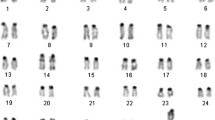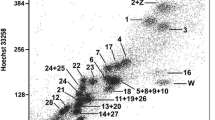Abstract
Canid species (dogs and foxes) have highly rearranged karyotypes and thus represent a challenge for conventional comparative cytogenetic studies. Among them, the domestic dog is one of the best-mapped species in mammals, constituting an ideal reference genome for comparative genomic study. Here we report the results of genome-wide comparative mapping of dog chromosome-specific probes onto chromosomes of the dhole, fennec fox, and gray fox, as well as the mapping of red fox chromosome-specific probes onto chromosomes of the corsac fox. We also present an integrated comparative chromosome map between the species studied here and all canids studied previously. The integrated map demonstrates an extensive conservation of whole chromosome arms across different canid species. In addition, we have generated a comprehensive genome phylogeny for the Canidae on the basis of the chromosome rearrangements revealed by comparative painting. This genome phylogeny has provided new insights into the karyotypic relationships among the canids. Our results, together with published data, allow the formulation of a likely Canidae ancestral karyotype (CAK, 2n = 82), and reveal that at least 6–24 chromosomal fission/fusion events are needed to convert the CAK karyotype to that of the modern canids.
Similar content being viewed by others
References
Bardeleben C, Moore RL, Wayne RK (2005) A molecular phylogeny of the Canidae based on six nuclear loci. Mol Phylogenet Evol 37: 815–831.
Biltueva L, Yang F, Vorobieva NV, Graphodatsky AS (2004) Comparative map between the domestic pig and dog. Mamm Genome 15: 809–818.
Bininda-Emonds ORP, Gittleman J, Purvis A (1999) Building large trees by combining phylogenetic information: a complete phylogeny of the extant Carnivora (Mammalia). Biol Rev 74: 143–173.
Bininda-Emonds ORB, Cardillo M, Jones KE et al. (2007) The delayed rise of present-day mammals. Nature 446: 507–512.
Breen M, Thomas R, Binns MM, Carter NP, Langford CF (1999) Reciprocal chromosome painting revealed detailed regions of conserved synteny between the karyotypes of the domestic dog (Canis familiaris) and human. Genomics 61: 145–155.
Breen M, Hitte C, Lorentzen TD et al. (2004) An integrated 4249 marker FISH/RH map of the canine genome. BMC Genomics 5: 65.
Cavagna P, Menotti A, Stanyon R (2000) Genomic homology of the domestic ferret with cats and humans. Mamm Genome 11: 866–870.
Dobigny G, Ducroz JF, Robinson TJ, Volobouev V (2004) Cytogenetics and cladistics. Syst Biol 53: 470–484.
Froenicke L, Muller-Navia K, Romanakis K, Scherthan H (1997) Zoo-FISH maps of the harbor seal (Phoca vitulina) and the putative ancestral carnivore karyotype. Chromosoma 106: 108–113.
Graphodatsky AS (2007) Comparative chromosomics. Mol Biol (Russ) 41: 408–422.
Graphodatsky AS, Radjabli SI (1981) Comparative cytogenetics of three canids species. Genetica (Russ) 17: 1498–1504.
Graphodatsky AS, Beklemisheva VR, Dolf G (1995) High resolution GTG-banding patterns of dog and silver fox chromosomes description and comparative analysis. Cytogenet Cell Genet 69: 226–231.
Graphodatsky AS, Yang F, O’Brien PC et al. (2000a) A comparative chromosome map of the Arctic fox, red fox and dog defined by chromosome painting and high resolution G-banding. Chromosome Res 8: 253–263.
Graphodatsky AS, Yang F, Serdukova N, Perelman P, Zhdanova N, Ferguson-Smith MA (2000b) Dog chromosome-specific paints reveal evolutionary inter- and intrachromosomal rearrangements in the American mink and human. Cytogenet Cell Genet 90: 275–278.
Graphodatsky AS, Yang F, O’Brien PCM et al. (2001) Phylogenetic implications of the 38 putative ancestral chromosome segments for four canid species. Cytogenet Cell Genet 92: 243–247.
Graphodatsky AS, Yang F, Perelman P et al. (2002) Comparative molecular cytogenetic studies in the order Carnivora: mapping chromosomal rearrangements onto the phylogenetic tree. Cytogenet Genome Res 96: 137–145.
Gustavsson I, Sundt CO (1967) Chromosome elimination in the evolution of the silver fox. J Hered 58: 75–78.
Hameister H, Klett C, Bruch J, Dixkens C, Vogel W, Christensen K (1997) Zoo-FISH analysis: the American mink (Mustela vison) closely resembles the cat karyotype. Chromosome Res 5: 5–11.
Kukekova AV, Trut LN, Oskina IN et al. (2007) A meiotic linkage map of the silver fox. Genome Res 17: 387–399.
Lindblad-Toh K, Wade CM, Mikkelsen TS et al. (2005) Genome sequence, comparative analysis and haplotype structure of the domestic dog. Nature 438: 803–819.
Mäkinen A, Gustavsson I (1982) A comparative chromosome-banding study in the silver fox, the blue fox, and their hybrids. Hereditas 97: 289–297.
Murphy WJ, Stanyon R, O’Brien SJ (2001) Evolution of mammalian genome organization inferred from comparative gene mapping. Genome Biol 2: 0005.1–0005.8.
Nash WG, Wienberg J, Ferguson-Smith MA, Menninger JC, O’Brien SJ (1998) Comparative genomics: tracking chromosome evolution in the family Ursidae using reciprocal chromosome painting. Cytogenet Cell Genet 83: 182–192.
Nash WG, Menninger JC, Wienberg J, Padilla-Nash HM, O’Brien SJ (2001) The pattern of phylogenomic evolution of the Canidae. Cytogenet Cell Genet 95: 210–224.
Nie W, Wang J, O’Brien PCM et al. (2002) The genome phylogeny of domestic cat, red panda and five mustelid species revealed by comparative chromosome painting and G-banding. Chromosome Res 10: 209–222.
Nie W, Wang J, Perelman P, Graphodatsky AS, Yang F (2003) Comparative chromosome painting defines the karyotypic relationships among the domestic dog, Chinese raccoon dog and Japanese raccoon dog. Chromosome Res 11: 735–740.
Perelman PL, Graphodatsky AS, Serdukova NA et al. (2005) Karyotypic conservatism in the Suborder Feliformia (Order Carnivora). Cytogenet Genome Res 108: 348–354.
Rettenberger G, Klett Ch, Zechner U et al. (1995) Zoo-FISH analysis: cat and human karyotypes closely resemble the putative ancestral mammalian karyotype. Chromosome Res 3: 479–486.
Seabright M (1971) A rapid banding technique for human chromosomes. Lancet 2: 971–972.
Swofford DL (1998) PAUP (1998). Phylogenetic Analysis Using Parsimony, version 4.0. Sunderland, MA: Sinauer Associates.
Tian Y, Nie W, Wang J, Yang F, Ferguson-Smith MA (2004) Chromosome evolution in bears: reconstructing phylogenetic relationships by cross-species chromosome painting. Chromosome Res 12: 55–63.
Trifonov VA, Perelman PL, Kawada SI, Iwasa MA, Oda SI, Graphodatsky AS (2002) Complex structure of B-chromosomes in two mammalian species: Apodemus peninsulae (Rodentia) and Nyctereutes procyonoides (Carnivora). Chromosome Res 10: 109–116.
Vila C, Maldonado JE, Wayne RK (1999) Phylogenetic relationships, evolution, and genetic diversity of the domestic dog. J Hered 90: 71–77.
Wayne RK, Nash WG, O’Brien SJ (1987a) Chromosome evolution of the Canidae I: species with high diploid numbers. Cytogenet Cell Genet 44: 123–133.
Wayne RK, Nash WG, O’Brien SJ (1987b) Chromosome evolution of the Canidae II: divergence from the primitive carnivore karyotype. Cytogenet Cell Genet 44: 134–141.
Wayne RK, Geffen E, Girman DJ, Koepfli KP, Lau LM, Marshall CR (1997) Molecular systematics of the Canidae. Syst Biol 46: 622–653.
Wienberg J, Stanyon R, Nash WG et al. (1997) Conservation of human vs. feline genome organization revealed by reciprocal chromosome painting. Cytogenet Cell Genet 77: 211–217.
Yang F, Graphodatsky AS (2004) Integrated comparative genome maps and their implications for karyotype evolution of carnivores. In: Schmid M, Nanda I, eds. Chromosomes Today, Vol. 14. Dordrecht: Kluwer Academic Publishers, pp. 215–224.
Yang F, O’Brien PC, Milne BS et al. (1999) A complete comparative chromosome map for the dog, red fox, and human and its integration with canine genetic maps. Genomics 62: 189–202.
Yang F, Graphodatsky AS, O’Brien PCM et al. (2000) Reciprocal chromosome painting illuminates the history of genome evolution of the domestic cat, dog and human. Chromosome Res 8: 393–404.
Author information
Authors and Affiliations
Corresponding author
Electronic supplementary material
Below is the link to the electronic supplementary material.
Supplementary Figure S1
Diploid G-banded karyotype of fennec fox and gray fox. Summary of hybridization pattern of domestic dog probes onto G-banded fennec fox and gray fox chromosomes (JPEG 501 kb)
Supplementary Figure S2
A single tree retrieved from PAUP analysis of 88 characters rooted on bears, with changes mapped onto the topology. Bootstrap values are provided above branches (JPEG 769 kb)
Supplementary Table S1
Matrix of chromosomal characters corresponding to presence (1) or absence (0) of segmental associations of dog chromosomal fragments (XLS 96 kb)
Rights and permissions
About this article
Cite this article
Graphodatsky, A.S., Perelman, P.L., Sokolovskaya, N.V. et al. Phylogenomics of the dog and fox family (Canidae, Carnivora) revealed by chromosome painting. Chromosome Res 16, 129–143 (2008). https://doi.org/10.1007/s10577-007-1203-5
Published:
Issue Date:
DOI: https://doi.org/10.1007/s10577-007-1203-5




